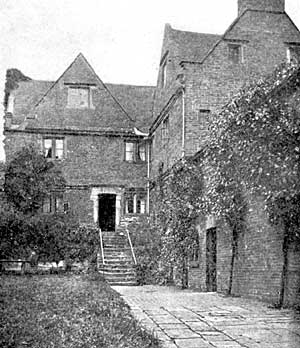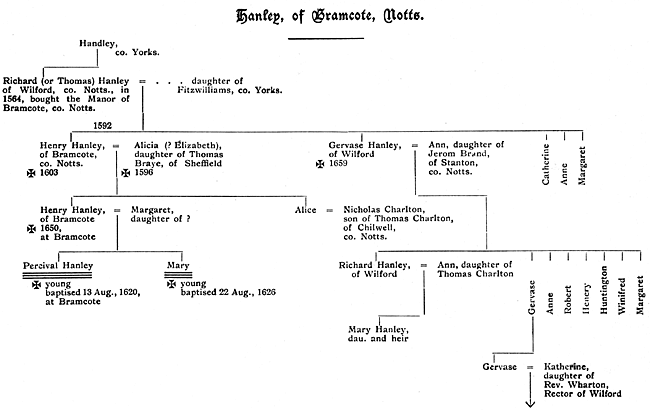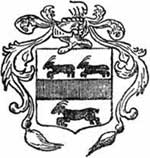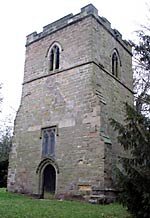The Family of Hanley, or Handley, of Bramcote
By George Fellows.

Manor House, Bramcote (photo: Harry Gill).
THE village of Bramcote has, in spite of its populous and industrial neighbours, so far withstood the intrusions of any form of manufacture, with its inevitable smudge of soot and smoke to detract from its rural charm. True, the lower end of the village is kept enlivened by the traffic passing along the main road between Nottingham and Derby; but the higher part of the village, where stands the isolated tower of the dismantled church, has an air of enjoyable tranquillity and seclusion.
It is on the slope of this hill, on the south side of the highest point, nearly 300ft. above sea level, that the old Jacobean manor-house associated with the family of Hanley is situated.
The first notice we have about the Hanleys, in connection with Nottinghamshire, is in the Torre MSS., where it is stated that the manor of Bramcote passed from the nuns of Sempringham, in Lincolnshire,1 14th July, 6, Elizabeth (1564), to Charles Jackson, and was subsequently purchased by Tho. Hanley, of Wilford. Dr. Thoroton gives the purchaser's name as Richard Handley, yeoman, and adds "left his son Henry, father of Henry at Bramcote and Jervas, his second son, who married An, the daughter of Jerome Brand of Stanton, at Wilford, where his posterity in the male line still continueth." From the pedigree of the family given in the Visitation of Nottinghamshire, it appears that the family came from Yorkshire, and the name of the purchaser of the manor of Bramcote was Thomas, not Richard as recorded by Dr. Thoroton.

 |
Before entering into detail as to the individual members of the family, it would be well to endeavour to determine whether the family name was Handley or Hanley. There is no doubt that those who lived at Bramcote and Wilford were of the same family, and there are many authorities for the use of either spelling of the name.
Dr. Thoroton gives the name as Handley (p. 209), and it is the same in the Visitations of Nottinghamshire: moreover no less an authority than the Garter King of Arms, in 1612, made them a grant of arms in the name of Handley.
On the other hand, in the church registers at Bramcote, where it is fair to suppose the entries were made, to some extent at least, under the supervision of some member of the family, the name appears consistently as Hanley, and in their own manor-house the name is perpetuated on the oak panelling in one of the chief rooms, as Hanley; and, furthermore, in Dr. Deering's history (appendix pp. 321-330), the deed and will of Henry Hanley, thus spelt, is set out. The alms-houses founded by them, which originally stood in Barker Gate and Stoney Street, Nottingham, are known as Hanley's Alms-houses, and the street adjoining perpetuates the name as Hanley Street.
Blackner, in his history, devotes some space to the family and their charities (p. 139), and he calls them Handley. There is no doubt, as already stated, that they were all one stock however their name appears, and that the senior branch at Bramcote adhered to the name Hanley. It may be mentioned that there are numerous Handley entries in the church registers at Balderton, near Newark ; but no connection has so far been established between them and those associated with the neighbourhood of Nottingham.
Richard or Thomas (whichever the name may have been), the purchaser of the manor of Bramcote, married a daughter of the Fitzwilliams of Yorkshire.2
His son and heir, Henry Hanley, gentleman, married Elizabeth Bray of St. Mary's parish, Nottingham, "on the feast of St. Andrew, the Apostle, 1592," as recorded in the registers of the church at Bramcote. It is a coincidence that William de Hanley and John Bray were patrons of the living of Radcliffe-on-Trent, in 1372, 225 years before the marriage in 1592.
In the History of Hallamshire Hunter speaks of a respectable family of the name of Handley of Hall Carr, near Sheffield, A branch of the Handley family, living near Sheffield, would explain the marriage of the Nottingham Handley to one of the Fitzwilliams.
Both in Dr. Thoroton's History and the Visitations her Christian name appears as Alicia ; but the registers, together with the inscription on the mural monument at Bramcote, must be regarded as conclusive evidence that her name was Elizabeth.
Henry Hanley's brother, Gervase, was established at Wilford, and took a philanthropic interest in the neighbouring town ; as may be seen in the Records of the Borough of Nottingham (vol. iv., p. 226), by the following entry :—
"Jervys Handley xij stryke of corne in aid of Plague Stricken poore 1592," and among "gyftes rec[eived] fo[r] Relyeffe of the Poore and disseisyed 8 Aug[ust] 1592," was one by Jervys Handlye consisting of "xij stryke of co[r]ne." 3
 The old church, Bramcote (photo: Andy Nicholson,
2006).
The old church, Bramcote (photo: Andy Nicholson,
2006).Of the old church at Bramcote, dedicated to St. Michael and All Angels, all except the tower was pulled down about the year 1861: this entailed a concentration into the tower of the mural monuments which had hitherto occupied positions in the body of the church. Here the monuments remained subject to damp, dust, and dirt, until the year 1916; when the enterprise and energy of the new incumbent (Rev. W. M. Browned, together with the practical co-operation of Major E. F. Holden, the present owner of the Bramcote estate, came to their rescue; and most of them were removed to the present modern church, situated lower down the village and now taking the place of the venerable building on the summit of the hill. Here the Hanley monuments may now be seen, except the alabaster one to Henry Hanley, which remains in the old tower. He died on the 12th November, 1603, seven years after his wife's decease.
(1) The Priory of Sempringham was founded
A.D. 1130-40 by St. Gilbert (hence the name Gilbertines), rector of Sempringham.
There was only one house of this order in Notts., namely, that at Mattersey,
an account of which may be found in the Thoroton Society's Transactions
for the year 1909.
(2) See Handley pedigree in Visitations of Notts., also Thoroton's
History. There is a paper on the old family of Fitzwilliams in the Ancestor,
No. 12 volume, pages 111 and 184. in which it states " the house of
Fitzwilliam thus begins its career with eight Knights fees in Yorkshire and
with illustrious kinsfolk."
(3) Bailey, in his Annals, makes no mention of there being any distress in
1592. There seems to have been a pestilence in Bramcote, in 1607, as there
were thirty-four burials recorded between August and December, in that year.
